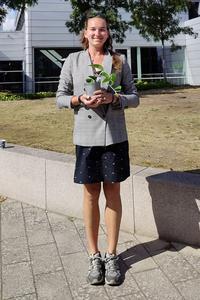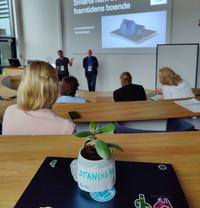Arts and Culture
Arts and culture at the Swedish Biodiversity Symposium
Mirka Duijn
Mirka Duijn is a documentary filmmaker, researcher, and film pedagogue based in Gothenburg. Her work explores how visual culture shapes ways of seeing and relating to the world, with a recent focus on ecology and landscape imaginaries. Her films and installations have been presented at international festivals, museums, and cultural institutions.
About the work
We Looked and Called It Nature (2025) is a work-in-progress film, filmed in Botaniska, Gothenburg. It begins from the filmmaker’s question of how ways of looking at nature—especially in gardens—shape one’s sense of connection to it. To understand this better, the filmmaker looks at the garden together with visitors, gardeners, botanists, and children. Each perspective reveals a different way of seeing, engaging with beauty, order, detail, care, and play. The finished installation will premiere at Röda Sten Konsthall, Gothenburg, in February 2026.
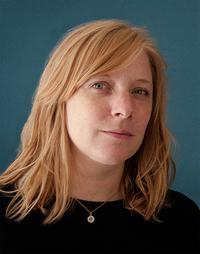
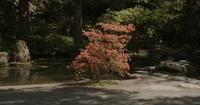
Una Holmquist
In Una Holmquist’s wood sculptures, the choice of carving material has become increasingly important—not only based on its physical properties, but also its origin as a tree and its role within an ecosystem. Central to her work is often the relationship between material and motif, where the material’s origin may contrast with the sculpture’s subject. Una’s art frequently touches on how bodies and nature change, adapt, or resist—a kind of poetic tenderness for what remains, a desire to hold on, firmly and gently.
About the works
Fäll medan det vita täcket faller
This sculpture depicts the forest orchid Goodyera repens (creeping lady’s tresses) and is made from spruce and pine sourced from cultivated coniferous forests in Sweden. The spruce wood comes from old Christmas trees, while the pine was found in clear-cut pine forests.
Goodyera repens thrives among older coniferous trees. Due to increased logging where forests are clear-cut at just 70–80 years of age, the orchid has declined significantly.
Reported sightings of Goodyera repens in cultivated forests can prevent clear-cutting. Surveyors aiming to protect forests may report findings of the orchid, indicating high ecological value in those areas. As a result, it has become beloved by many nature enthusiasts and disliked by many forest owners. Despite its modest height of just 10–20 cm (stem), Goodyera repens has become a highly charged plant with divided opinions.
Mäta ödet åt människors barn
This artwork depicts the forest orchid Calypso bulbosa (fairy slipper). The fairy slipper is sensitive to major environmental disturbances and usually does not survive final logging. It does not produce its own nectar but blooms at the same time as blueberries, which attract pollinating bumblebees. The bees crawl deep into the fairy slipper’s flower, drawn by its vanilla scent. However, the bumblebees need the sweet nectar of blueberries as flight fuel. Blueberries are sensitive to clear-cutting and do not thrive in dense, cultivated forests. Without blueberries or other bumblebee-attracting flowers, the fairy slipper cannot reproduce.
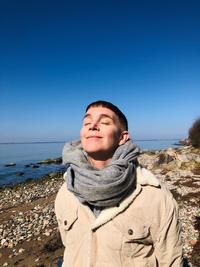
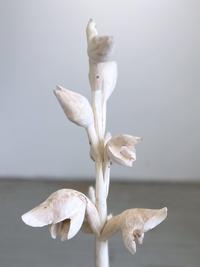
The Unseen Ocean Collective
The Unseen Ocean Collective is a collaboration between three artists—Meghan Jones, Kierstin Keller, and Nilanjana Das—and marine biologist Lara Beckmann. Through immersive sculptures and paintings inspired by deep-sea ecosystems, the group aims to unite science and art to spark engagement and emotional connection with life in the ocean’s depths.
About the works
The artworks are inspired by underwater footage from areas in Alaska and the North Atlantic. They depict vibrant and ecologically important coral and sponge communities, showcasing their rich diversity of organisms. The goal is to inspire both curiosity and emotional connection to the deep sea—a world that covers most of our planet but is rarely on our minds.
During the symposium, we are showing:
- An immersive 3D sculpture of a habitat-forming coral by Nilanjana Das (Corvallis, Oregon).
- Three colorful paintings by Meghan Jones (Spokane, Washington), highlighting species and interactions in the deep sea.
- 1–2 prints by Kierstin Keller (Juneau, Alaska).
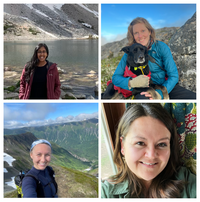
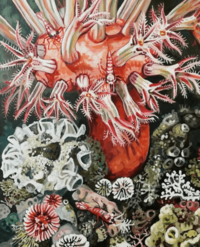
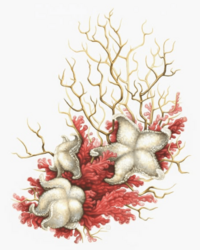
Katka Katerina Cerna
Katka Katerina Cerna is a designer, educator, and artist working with more-than-human design. In a time when we face potentially dramatic changes in social and ecological systems, she explores how we can transform our own and others’ relationships with the green nature by shifting the perspective from a solely human-centered view to something beyond that.
About the work
Katka Katerina Cerna contributes to the symposium with her interactive performance. She will participate together with a small plant named Stanislav, playing with the idea of plant participation: what happens if we decide that Stanislav is attending the conference, and how might this help us reshape our relationships with nature—both on an individual level and within society?
